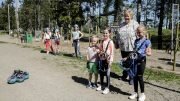When Norway closed down in March, its citizens proceeded to hoard sustainable food. They started baking and they changed their eating patterns and shopping habits.
However, figures published in September suggest that not all of the new habits will last.
Nielsen Norway has looked at sales developments for the grocery market in the coronavirus period between week 11 and week 32, from March 9 to August 9.
Unsurprisingly, people bought more groceries while restaurants and canteens have been closed.
Strict infection control measures have also affected cross-border trade and travel abroad.
Some food categories were obviously sales “winners,” while others had lower growth.
“During the pandemic, we have so far seen a relative decline in demand for products that are typically enjoyed on the go,” communications manager Gunnar Portvik at Nielsen told news bureau NTB at the time.
“Less money is invested in fresh small dishes such as small baked products and sushi, while the growth of muesli bars changed into a decline,” Portvik added.
Sales of portion packs, for example, with yogurt, have also declined during the pandemic.
This development is apparently in stark contrast to the trend in recent years where snacks registered huge growth, a trend referred to as “snacking,” as it has become common to eat and drink between main meals without actually being hungry or thirsty.
Spike in baking
However, there is no reason to believe that Norwegians have stopped enjoying themselves or eating snacks.
They may have just changed the pattern and now make their snacks themselves.
Norwegians have been baking a lot during the pandemic, and flour turnover has increased by as much as 49%, while yeast turnover is up 87% so far during the pandemic.
Elisabeth Aandstad Ekheim, Communications Director at Orkla Norway, confirmed this impression.
“When home office became the new everyday life for many, people started to bake.
“Yeast was one of our products with the largest increase in sales in the first phase, in addition to sweet baking mixes.
“The demand for yeast continued throughout the spring, and there is no doubt that a lot of baking is still going on in Norwegian homes,” she said.
The baking craze is likely connected to the fact that people had time for meals at home.
Hoarding phase
The pandemic’s first phase was characterized by the hoarding of foods, medicine, and toilet paper.
It was the result of a certain level of panic, as it was suddenly inappropriate for people to go to the store several times a week, as they usually do.
“The pandemic changed our action patterns. At least for a while. Fewer store visits led to an increasing need for more foods with a longer shelf life, which led to a particular increase in purchases of frozen and packaged food,” Portvik in Nielsen pointed out.
Sales of products with a long shelf life, such as canned food and soups, were 36% and 17% higher, respectively, than last year in the same period.
However, as much as 85% and 99% of this growth, respectively, came in just the first four weeks after Norway closed down.
Pasta, rice, canned meat, and various lasting dinner dishes and stews also registered a formidable increase in the first four weeks, before the situation calmed down to an extent.
Nielsen Norway believes that the growing demand for canned food, frozen goods, pasta, and rice may have been short-lived.
Tobacco on the rise
Tobacco is the product category that increased its turnover the most during the corona period.
That is due to the fact that Norwegians do not have their usual access to cross-border trade and tax-free trade.
In total, in Norway, tobacco sales have increased by 53% between weeks 11 and 32, and sales are continuing to grow in all counties.
“In the former Østfold county, tobacco sales increased by almost 200%,” Portvik noted.
Again, there is reason to believe that the increase is due to the fact that Norwegians have been in the habit of buying a lot of tobacco tax-free or on the other side of the border in Sweden, especially during the holidays.
With more Norwegians staying at home this summer, it is no wonder that the sales of snus, cigarettes, and tobacco in Norway are increasing.
© NTB Scanpix / #Norway Today





Be the first to comment on "The coronavirus pandemic has changed eating habits in Norway. Here’s how"